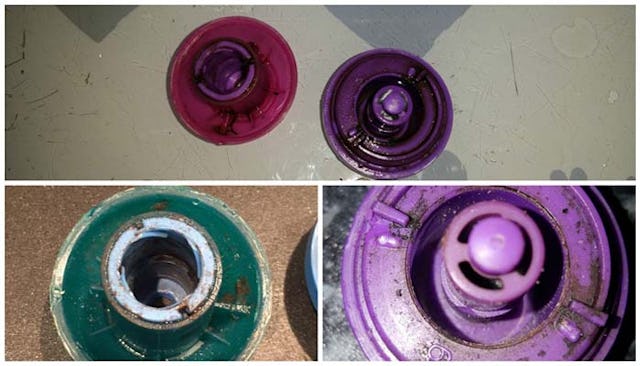PSA: You're Probably Not Cleaning Your Sippy Cup Right

Last week, a dad took to Facebook to post a picture of a cup his child’s been drinking from. It has parts that are almost impossible to get to, and when dad finally managed to get them apart, he realized there was dark mold hiding in the crevices he hadn’t seen.
Craig Beresford claims in his post that he’s been absolutely meticulous cleaning the bottle and cap every day, but after noticing his child was having a persistent upset stomach, he decided to take it apart. “It isn’t designed to be taken apart and requires a bit of force to disassemble,” he says. “The internal components have been hoarding bacteria. We were horrified and heartbroken that our little girl had been using this bottle in this state.”
Parents immediately began checking their cups and finding the same issue: mold hidden in the interior of the cup. The problem with this particular cup seems to be that you cannot easily take it apart, so it’s hard to discern if you’re having a mold issue. Parents uploaded dozens of photos in the comments, all with the same issue.
Gross mold.
How many sippy cups or other cups meant for kids have you thrown away because you found something moldy when you took the pieces apart? Admit it, it’s happened to all of us.
Here’s the thing: no one reads instructions on a cup. Seriously — who does that? So we buy certain cups for our young children, we think we’re washing them fine, and then one day we take all the pieces apart and vomit in our mouths a little. Then it never happens again.
So in case you had no idea, bacteria, food, moisture, and hidden plastic products do not mix. If you own a kid’s cup that has many parts or hidden parts, you may be shocked to find some hidden yuck when you finally take it apart and clean it right.
Sistema, the company who makes the cups pictured responded to the dad’s complaint, saying “We manufacture our caps to meet international child safety standards and it is for this reason they can be difficult to disassemble.” Therein lies the rub: nobody wants small, loose pieces of plastic on a child’s cup. Cups need to conform to a certain safety standard so it makes sense that they are hard to take apart. The company made several videos explaining how to clean the bottles properly. These are helpful even if you don’t own this particular bottle. How many of us have sport bottles for our children? *Raises hand*
Other sites that sell kid’s cups also have step-by-step instructions. Don’t be embarrassed if you’ve never followed them. Here’s some advice for keeping your cups clean from NuSpin Kids:
1. Wash the cup immediately after each use.
2. FULLY disassemble the cup. Moisture and food collect in the joints between parts, which is exactly the type of place where mold can grow. Separate all straws, valves, rubber rings, plastic sliding covers, and so on.
3. Pre-rinse straws, valves, and other parts that collect food with warm water. Most rubber valves can be opened by pinching with your fingers. Pinch the valve and run water through it to pre-rinse.
4. Wash by hand in warm soapy water, or by dishwasher.
5. Shake out remaining water from all parts. Shake out any water collected inside straws. If your cup or straw has a rubber valve, pinch it open while you shake to get the water out.
6. FULLY dry all parts before assembly. This is a key step since moist parts won’t dry once assembled. Consider storing the cup disassembled, and assemble only when ready to use.
Make sure you let all the pieces fully dry before putting them back together. If you don’t have a dishwasher, make sure you have some kind of long bristle brush to get down in all the crevices and clean the cup properly.
Voila! No more gross mold and no more gagging and feeling like a terrible parent.
This article was originally published on